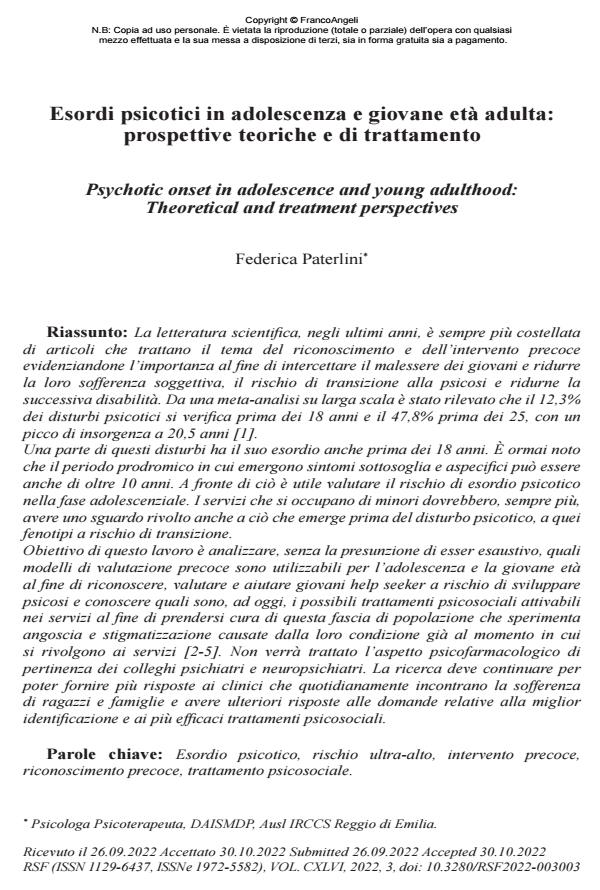Psychotic onset in adolescence and young adulthood: Theoretical and treatment perspectives
Journal title RIVISTA SPERIMENTALE DI FRENIATRIA
Author/s Federica Paterlini
Publishing Year 2022 Issue 2022/3
Language Italian Pages 30 P. 31-60 File size 259 KB
DOI 10.3280/RSF2022-003003
DOI is like a bar code for intellectual property: to have more infomation
click here
Below, you can see the article first page
If you want to buy this article in PDF format, you can do it, following the instructions to buy download credits

FrancoAngeli is member of Publishers International Linking Association, Inc (PILA), a not-for-profit association which run the CrossRef service enabling links to and from online scholarly content.
The scientific literature, in recent years, is increasingly studded with articles that deal with the theme of early recognition and intervention, highlighting its importance in order to intercept the distress of young people and reduce their subjective suffering, the risk of transition to psychosis and reduce the subsequent disability. A large-scale meta-analysis found that 12.3% of psychotic disorders occur before the age of 18 and 47.8% before the age of 25, with a peak of onset at 20.5 years [1]. Some of these disorders have their onset before the age of 18. It is now known that the prodromal period in which nuanced, subthreshold and non-specific symptoms emerge can be over 10 years. In view of this, it is useful to evaluate the risk of psychotic onset in the adolescent phase. Services that deal with minors should increasingly have a look also at what emerges before the psychotic disorder, at those phenotypes at risk of transition. The aim of this work is to analyze, without presuming to be exhaustive, which early assessment models can be used for adolescence and young age in order to recognize, evaluate and help young help seekers at risk of developing psychosis and to know which are, to date, the possible psychosocial treatments that can be activated in the services in order to take care of this segment of the population that experiences anguish and stigmatization caused by their psychological condition when they access mental health services [2-5]. The psychopharmacological aspect pertaining to psychiatric and neuropsychiatric colleagues will not be treated. Research should provide answers to clinicians who daily encounter the suffering of children and families and focus on the best identification and the most effective psychosocial treatments.
Keywords: Psychotic onset, ultra-high risk, Early intervention, Early identification, Early recognition, Psychosocial treatment.
Federica Paterlini, Esordi psicotici in adolescenza e giovane età adulta: prospettive teoriche e di trattamento in "RIVISTA SPERIMENTALE DI FRENIATRIA" 3/2022, pp 31-60, DOI: 10.3280/RSF2022-003003